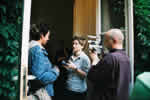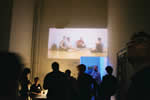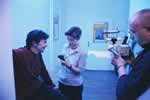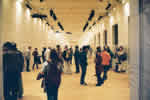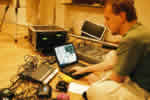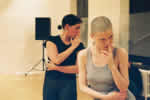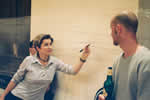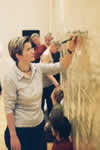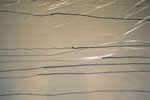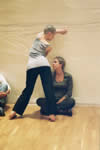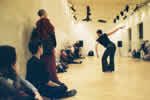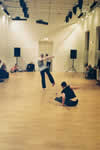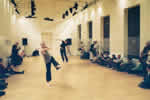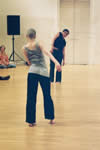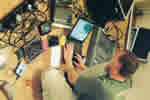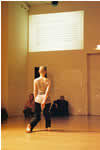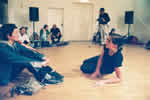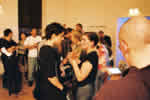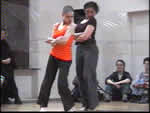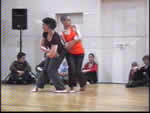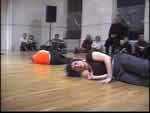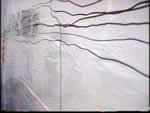| |
|
back
Description
of the Laboratories for Performance and
Post-Dramatic Acting
by Sabine Sonnenschein
(Dance) performance extinguishes itself and leaves but a trace.
(Dance) performance is an art form of the present.
How does post-dramatic performative acting articulate?
How does reception become participation in performance and live art?
"Post-dramatic
theatre is theatre of the present. (The) present is necessarily erosion
and slipping away of presence.
It signifies an event which empties the Now, and in this void itself
lets memory and anticipation flare up. Present is not something which
can be grasped conceptually, but a process of permanent self-division
of the Now into ever new splinters of 'just now' and 'now soon'. It
has more to do with the death of the theatre than its much-invoked
'life'.
Heiner Müller: 'The specific thing about theatre is not the presence
of the living onlooker, but the presence of the transient, the potentially
dying.'
(...)
Present in the sense of a buoyant, dwindling attendance, which at
the same time is experienced as "away", not-there, as going
away already, in post-dramatic theatre crosses out dramatic representation."1
(Hans-Thies Lehmann, Postdramatisches Theater, 1999)
"The
'fleeting' aspect of the trace simply destroys the weight of presence.
The trace has always related an element of the sign to another system
of traces' traces, to other absences' absences."2
(André Lepecki in his article "Manically charged presence"
with respect to Jacques Derrida's term "Trace" and its meaning
for dance and drama studies)
"Art
points into a sordid absence, a suffocating condensation where being
ceaselessly perpetuates itself as nothingness."3
(Maurice Blanchot)
________________
1.
The specific angle of this laboratory series is an exchange practice,
a co-operative encounter of female and male performers, musicians
/ sound designers, visual artists, art and culture theoreticians,
philosophers and researchers of theatre study, making it possible
to receive impulses from each other and to put new approaches to the
test. A direct connection of art practice and theory production is
intended. Exchange and research are the main aspects. No production
is developed, but sketches and processes are made public at certain
times in which the visitors may participate in various forms for free
or a "pay as you wish" fee. The aim is to employ the special skills
/ competences of the participants without denying redefinitions of
roles that are enriching rather than levelling down. Each of the series'
laboratories is based on teamwork; all the participants are equally
responsible for the lab. The single labs build upon each other. With
some participants, the exchange stretches over several labs. There
is no fixed team. The initiator organises the frame conditions, invites
the participants, has herself participated in every laboratory up
to now, and is responsible for the further development of the lab
series.
2.
Until now, the process was made public eight times:
The first date, do your solo & join the group with Andrea Bold
(performer), Jack Hauser (performer), Anita Kaya (performer), Amadeus
Kronheim (performer, sound creator), Gerald Raunig (philosopher, art
theoretician), Isolde Schober (performer), Sabine Sonnenschein (performer),
Katherina Zakravsky (philosopher, culture theoretician, performer)
focused on solo and group improvisation: all participants supplied
text input beforehand. A preparatory meeting and a joint improvised
laboratory performance took place.
The
rather more time-consumingly designed Lab
for Performance and Post-Dramatic Acting 2 with Boris Hauf
(sound designer), Sabina Holzer (performer), Marty Huber (theatre
theoretician), Gerald Raunig (philosopher) and Sabine Sonnenschein
(performer) dealt with the topics of "difference and repetition",
"antagonism" and "border".
Texts by Ernesto Laclau/Chantal Mouffe, Gilles Deleuze and Gerald
Raunig were used as sources.
A discussion about theoremes was the starting point for performative
improvisation work.
A public performative sketch was created; it took place in Im_flieger,
its anteroom and in the WUK-Beisl. Stepping forward in the theoretical
field was connected with text production.
The
same team continues this discussion in Lab
for Performance and Post-Dramatic Acting 2.2:
By means of the thematic nodes "difference and repetition", "antagonism"
and "border", a formal framework is created, on the basis of which
the overlay possibilities of performance and theory production as
well as of action and reception are researched, and possible ways
from performance in the direction of post-dramatic acting are explored.
"That which counts is not just the two opposed camps with their
line of confrontation; that which counts also is the border, over
which everything happens and trails away on a differently oriented
molecular fraction line."4
Two public performative sketches were created in which forms of representation
were questioned, dislodged and overlaid. These sketches, taking place
in Im_flieger and its anteroom, were structured in three parts:
In the first part, interviews were made with visitors in the anteroom,
which was equipped with sound, texts concerning the lab, the projection
of a video without sound on which a lecture by Gerald Raunig about
representation and a subsequent discussion of the lab team could be
seen, and offered drinks and snacks. In order to explain one of their
working approaches in the lab in one-to-one lectures, performers took
single visitors into the room of the performance that was to follow
in the second part. After about 30 minutes, all entered the performance
space together, and part two began. Here Marty Huber circled incessantly,
drawing an interminable vanishing line along the wall. The interview
and movement material from part one was now utilised distinctly within
the representative framework of the performance. The statements of
those interviewed before could be heard and were subsequently overlaid
by electronic sounds by Boris Hauf. At first, the movement material
of the performers was determined by the topics of difference and repetition.
This was followed by a discourse of the five participants about absolute
borders, moving of borders and border spaces - a structured joint
improvisation with talk, movement and sound. Here Marty had the interminable
vanishing line continued by visitors, then taking the pencil herself
again to continue drawing. In the third part, the room - accompanied
by the sound of the introduction of Gerald Raunig's lecture about
representation (soon alienated and overlaid with sounds from part
one), by the projection of texts and the repeated lecture part of
the performers - eventually turns into a chill-out room with drinks
and snacks, a room for talking.
The
initial point for Lab for
Performance and Post-Dramatic Acting 3.1 in January, 2002
with Boris Hauf (sound designer), Sabina Holzer (performer), Heike
Oehlschlägel (theatre theoretician), Michaela Pöschl (art theoretician,
visual artist) and Sabine Sonnenschein (performer) were texts by Hannah
Arendt and Maurice Merleau-Ponty: Hannah Arendts demand for publicity,
her emphasis on the space of appearance that forms between people
through acting and talking, as well as her metaphorical usage of the
terms theatre, actor/actress, and onlooker are matters of interest
for (dance) performance. In "The Thinking", Arendt takes the world
as an appearance, and directly refers to the phenomenologist Maurice
Merleau-Ponty, whose text "Intertwining - Chiasm" and the term "flesh"
contained in it will likewise be central issues of the lab.
"Acting is the only action of the Vita Activa, which takes place directly
between people without the mediation of matter, material and objects."5
(...) "This Between in space is the space of appearance in the
most general sense, the space which is created when people appear
before each other, and in which they are not only present like other
animate or inanimate objects, but expressly make an appearance."6
In Lab...3.1, there were discussions on the one hand - about
actions taking place between people, the world as a phenomenon, the
surface, the image, images of bodies, the connection between body
and thought, touching and being touched, and the "flesh" of the world.
On the other hand, improvisations took place based on these talks,
in which some of the theoreticians also took part. Every day, there
was a period of body training for all. Several elements took shape
as material that was freely used in jams: eye contact; dance; reading
from a text by Merleau-Ponty about colour perception; reading of texts
by Arendt about the network of relations of human issues, acting and
talking that leaves no tangible results and final products, and about
appearance, seeming and surface; texts by Kathy Acker about sex and
loneliness, in which the question "Who is talking?" is highly present
as the person of the narrator repeatedly changes its sex; silence;
darkness; opening the windows and thus opening the room towards the
street; (via soundtape) a man talks about his face; a woman's text
about her scars is present in a video projection; text via slide projection,…
The public dates of the lab took place in the form of a "two-part
talk": part one was a "discussion" in which the lab participants used
their "argumentations" like building blocks, the combination of blocks
being variable. The languages or forms of articulation used in this
discussion were movement, dance, technical instructions (spoken live),
live reading of (theoretical) texts, spoken text as sound source on
a sound carrier, electronic sounds, and written text via slide and
video projection. The argumentations thus articulated related to each
other, contextualised, overlaid and disturbed each other; they were
based on the material mentioned above that had come up during the
work. Part two was a discussion, a talk of all present about the laboratory's
contents.
In April 2002 Laboratory
for Performance and Post-Dramatic Acting 3.2 took place with
Nicole Haitzinger (dance and theatre theoretician), Martin Nachbar
(performer), Stefan Nowotny (philosopher), Michaela Pöschl (art theoretician,
visual artist) and Sabine Sonnenschein (performer) at Tanzquartier
Wien.
The discourse with texts by Hannah Arendt and Maurice Merleau-Ponty
went a completely different way than in January. Hannah Arendt calls
bodily needs and feelings as extremely private, she draws a clear
border between political publicity and privacy. What part does the
body play in politics? On the one hand, the body in Foucault's sense
is the inscription plane of discoursive regimes, an effect of power;
on the other hand, the movements of the body are inscribed in its
surroundings, acting affects the social order. The body cannot be
textualised entirely, its physical materiality has a potential of
resistance. In order to follow the question of political articulation
via the body, the lab team on April 13 has done interviews and made
video recordings around the neo-nazi demonstration against the exhibition
"Crimes of the German Wehrmacht" and the counter-demonstration under
the title "Prevent the Nazi March". The team did not search for the
flat stereotypes in corporeal appearance that are accompanied by a
clear classification, but for displacements, for gestures uncorrelated
with or relativising that which was spoken. What can be articulated
via the body?
The practical trial installations centered around touching and being
touched, handiness (referring to Martin Heidegger's "Zuhandenheit
des Zeugs" / "handiness of things"), and working with instructions
given by the participants to each other. In Lab...3.2 there was also
a daily body training for all the participants. The philosopher Gerda
Ambros who has deeply gone into Hannah Arendt's opus, was involved
in the lab as a guest. She held a lecture about Arendt, followed by
a discussion with the lab participants.
During the public dates, the performers shunned "performance" and
held conversations with the visitors on the topics of political articulation
via the body, privacy and publicity of the body, the body as determinator
of the "I" which is subject as well as object, and related to the
events of April 13. The conversations took place in TQW and around
Heldenplatz; the memory of the intense bodily experience of the demonstrations
was activated by revisiting Heldenplatz, where passers-by could be
involved in talks about April 13th.
"If
we insist on the participatory spectator, we have to renounce the
performance."7 To renounce the performance
means leaving the secure framework, enabling participation, making
room for the proprioception8 of all participants.
Post-dramatic acting takes place where the performers withdraw, where
participation takes place or reception is endowed with a highly active
component. The Lab for Performance and Post-Dramatic Acting
is based on the intention that theory and art practice should also
venture forth from secure territory: among other things, this means displacement, intervention, tactics
instead of strategy, re-signification by queer cooking instead of
reproduction of the specialty of the house.
3.
Up to now, most of the public appointments took place in Im_flieger;
which is a joint project of the 25 dance, theatre and performance
groups working in the Viennese WUK, who adapted one of their rehearsal
rooms as performance space. The studio character remains and creates
space for artistic processes not conforming to conventional performance
practice, for theoretical and practical exchange, discussion and discourse.
Apart from the rehearsals, up to five performances a month can be
realised with little technical and organisatorial expense.
The idea is to create for the free Viennese dance, theatre and performance
scene a public space for contemporary artistic discourse, experiments
and international exchange, co-ordinated by an artist collective.
_____________________________________________________________
1) Hans-Thies Lehmann, Postdramatisches Theater; Verlag
der Autoren, 1999, p. 259-260
2) André Lepecki, Manisch aufgeladene Gegenwärtigkeit;
in: ballett international/tanz aktuell Jahrbuch 1999, p. 86
3) Maurice Blanchot, The Original Experience, in: The Space of Literature;
University of Nebraska Press, 1982;
zit. aus: Clive Cazeaux, The Continental Aesthetics Reader; Routledge,
2000, p. 350
4)
Gilles Deleuze/Claire Parnet: Dialoge; Suhrkamp, 1980, S.142
5) Hannah Arendt, "Vita Activa",Piper, 2001, p.17
6) ibid., p.250
7) Emil Hvratin, in Janus, 9/01, p. 66
8) Perception of one's own body. See Marie-Luise Angerer, body options:
körper.spuren.medien.bilder; Turia + Kant, Vienna, 1999,
p. 178

|
| |
|
Participants
(November 2000 - April 2002):
Andrea Bold:
*1967, A
Performer.
Came to Vienna from Cologne, and moves since in the areas of dance,
performance and classical piano. She creates her own pieces, teaches
at the Bruckner Konservatorium in Linz and was member of the Damen-Improvisation
& Herren-BIGbäng (1995 - 99). Her Education led from studies
of Rhythmik and classical piano to contemporary dance-techniques (Release,
Contact Improvisation, Klein Technique), ballet, yoga and Qi gong. She
spent two years in New York (working among others at the Movement Research
Institute, the Susan Klein School of dance and the Jivamukti Yoga Center)
and is approved Craniosacral therapist.
Nicole
Haitzinger:
*1976, A
Dance and theatre theoretician.
1994-2000 theatre studies at Vienna university, journalism and communication
(specialsing in public relations and advertising). Diploma thesis: Real-Time
Composition, an art research project in the border area of theatre,
performance and dance. Since autumn 2000 studying for doctorate and
dissertation on theatre studies (working title: Attempt on a phenomenology
of European dance performance - terminology body - space - time), specialising
in dance studies. Autumn 2001: Research grant for scientific work with
Prof. Dr. Claudia Jeschke, department of dance studies, Cologne university.
Projects:
1999: Scientific observer and research for the European art project
"Real-Time-Composition", organised by Re.al in Lisbon, in the framework
of her diploma (as scholarship holder).
1999: Project oriented co-operation in T Junction Contemporary Dance
and Performance (Project by Nigel Charnock, audited by João Fiadeiro.)
2000: Tutor at Vienna university / Institute for theatre studies with
Univ.Ass. Mag. Fuxjäger.
2001: supervision of the project "Black Honey Drops", a co-operation
of Akemi Takeya and Ko Murobushi (ImpulsTanz Festival, Museumsquartier,
Vienna).
2001: Attendance and documentation of the choreographic workshop "Thought,
Poetry and Body in Action" by Vera Mantero at "Tanz im August" in Berlin.
November 2001: Documentation and scientific attendance of the research
project "Autorschaft" with Liz King, Philipp Gehmacher and Pilottanzt
in Tanzquartier Vienna.
Boris Hauf:
*1974, UK
Sound creator, musician.
Cello und piano studies in london and at the conservatory of vienna,
austria;
saxophone studies at the bruckner conservatory linz; flute studies with
katrina emtage and marc grauwels;
philosophy and musicology studies at the vienna university; autodidactic
studies in composition, instrumentation and counterpoint; studies at
SAMT (studio for advanced music & media technology), linz.
Concerts in europe, north africa, latin america and the usa.
Comissioned compositions for international festivals, radio- & tv-stations,
film, ensembles, solists and theater.
International grants and prizes.
8 CD releases, for example on Durian, Mego, Extraplatte:
...efzeg/ grain (durian 012), 2000 /// efzeg: (EX 361-2);1998 /// the
eschelberg takes (strynx records at-n 1401-1);1998 /// fuckhead: video
arena (PA 12); 1995 // /fuckhead: The Male Comedy (mego 025); 1998 ///
Das Eigene, GrabenFestTage 1998: Novotny/Kurzmann/Lehn/Mütter/Hauf-
Josef & Josef. Unsere Automaten (Josef Novotny) (EX-374-2); 1998...
Founder of efzeg; co-founder of pull my daisy; member of ensemble 68;
member of nouvelle cuisine, plays/records with fuckhead, co-operations.
Collaboration with Vera Mantero (P) in "Um estar aqui cheio" and with
Sabina Holzer, Litó Walkey and Marty Huber in "der Ort des Begehrens
ist, wo der Traum brüchig wird". Was involved in the improvisation project
"not to know" by Andrew Harwood and Benoît Lachambre at "ImPulsTanz",
Vienna.
Jack
Hauser:
*1958, A
Performer, musician; works with various media.
Studied electro-acoustic music 1983-85.
Experimental work with various media in a supercontext.
Collective art with David Ender, Lux Flux, Miryam van Doren, Luther
Blissett & Carte de tendre.
Member of the Invisible College & Austria Filmmakers Coop.
Sabina
Holzer:
*1966, A
Performer.
Studied physical theatre in Austria and France and contemporary dance
and performance at the Hoogeschool voor de Kunsten Amsterdam. Her approach
is strongly influenced by J.Hamilton, R.Zapora, D.Fleming, L.Booth.
Since 1994 she develops her own work, which has been shown in Nl, G,
A, FR, [for example "Faint voices at their loudest" (solo),
"bodies unfold" (duo), presented at festivals like Moving
Mime (NL), Mimos (FR) or Pandorrafestival (A)].
Since 1998 she lives in Vienna, as a performer closely related to Bilderwerfer
(Daniel Aschwanden) and Toxic Dreams (Josi Wanunu).
She creates her own work in cooperation with e.g. Jörg Weber (Theater
des Augenblicks), Sonja Schmidlehner, Oliver Schrader, Sabine Sonnenschein
(Lab for Performance and Post-Dramatic Acting) and since August 2001
with Vera Mantero ("thought, poetry and the body in action",
"un etre ici plein", "new creation 2002 - V.Matero and guests").
In 2002 she presented the performance "der Ort des Begehrens ist dort,
wo der Traum brüchig wird" in collaboration with Boris Hauf, Litó Walkey
and Marty Huber at dietheater Künstlerhaus.
Marty
Huber:
*1973, A
Performance theoretician, theatre scientist, free dramatic adviser.
Lives in Vienna.
Chairwoman of Rosa Lila Tip, a consultancy and information institution
for lesbians and gays,
founding member of the forum theatre group "seitenweXel",
former staff member of MAIZ (Linz) in connection with their language
acquisition and culture programme.
Dramaturgic works with Barbara Kraus, FOXFIRE Theatre, Sabina Holzer
and Bilderwerfer.
Momentarily working on her dissertation "Gender - Politics - Performance
in East-West Comparison".
Anita
Kaya:
*1961, A
Choreographer, dancer, performer, videoartist.
Lives in Vienna.
Studies include: experimental theatre in Vienna and contemporary dance
in Vienna, Germany and New York (grants by the Federal Ministry of Education,
Science and Arts / Austria in 1992 and 1995), educated in movement analysis
and movement notation. Since 1984 working as dance performer in various
dance and theatre productions (like T-Junction-project with Nigel Charnock).
Founded OYA-Produktion in 1988, and since then artistic director, choreographer
and dancer in various dance productions, performances, installations,
site-specific performances, improvisation projects and dance videos
(TSURU TSURU, BACKSPACE, LET YOUR HAIR DOWN, MODUL 1+1), which have
been performed on festivals in Austria, Germany, Hungary, Italy, Mexico
and Finland. 1999 Artist in Residence at Zodiak - Center for New Dance.
Artistic cooperation with artists in the field of dance, theatre, photography,
video, film and music. Teaching contemporary dance, butoh and improvisation.
Member of the BUTTERFLY EFFECT NETWORK
Amadeus
Kronheim:
*1963, A
Musician, performer.
Continuously changes sides between acting, music and dance. Grown up
in Linz, Ireland and the Mühlviertel, he lives in Vienna, where
he works/worked with various groups of the free dance and theatre scene:
e.g. with Carpa Theater, Lux Flux, Miki Malör and Damen-Improvisation
& Herren-BIGbäng. During the last years, he has increasingly
acted as a dancing non-dancer: Magazin mit allen Haremsfallen (1996),Charley's
Tanten (1997), drüsch - enthaart & gemäht (1999), hüpfen
zentral (2000). Temporary studies of musicology and electro-acoustics,
sound technician.
Martin
Nachbar:
*1971, D
Performer.
1996-1992 studies at SNDO, Amsterdam (diploma). 1995 studies and work
in New York in various places and with different people.
1996 performer in "eat, eat, eat" by Hans v.d. Broeck of Les Ballets
C. de la B., Gent.
1997-1998 performer in "better a blip than a blop" by Martin Butler
for the National Ballet, Amsterdam; making of "undressed" and "photographic
memory", both premiered in Amsterdam; making of "corrupt patience",
performance installation shown in gallery "UI", Amsterdam.
1998-1999 studies at PARTS, Brussels.
1999 performer in and co-maker of "events for television (again)" by
Tom Plischke and the B.D.C.; performer in "aviation/abreviation" by
Schiyo Takahashi, Antwerp.
2000 making of "ReKonstrukt", premiere in May in LOFFT, Leipzig; reconstruction
of "Affectos Humanos" for "affects/rework" by Joachim Gerstmeier, Martin
Nachbar and Tom Plischke; premiere in February in Mousonturm, Frankfort.
2001 performer in "re(sort)" by Tom Plischke.
Stefan Nowotny:
*1968, A
Philosopher, publicist.
Lives in Brussels and Vienna. Philosophy diploma at Vienna university,
doctorate studies at Vienna university. Currently at Louvain-la-Neuve
university, Belgium.
His main topics in research and work are: critical scrutiny of the "culture"
discourse, theory of culturalism and racism, theory of the archivarian
"memory", political theory, phenomenology.
Co-editor of: "Michel Henry. Zur Selbsterprobung des Lebens und
der Kultur", (with Rolf Kühn), Alber, 2002 and "Grenzen des Kulturkonzepts.
Meta-Genealogien", (with Michael Staudigl), Turia + Kant 2003; various
contributions in philosophical publications and magazines (Falter, Kultur-Risse,
Kultur, Triebwerk etc.); lectures in academical, art and adult education
institutions; co-organisation and -conception of research seminars at
Vienna university; freelance culture work and theoretical co-operation
in art projects (e.g. lecture perfomance with the singer Agnes Heginger
in the framework of "rush hour" in Kunsthalle Wien, 1997; basic and
conceptual work for the film project "Altes Haus. Szenen einer Erinnerung"
by Friedemann Derschmidt, premiere presumably 2002). Political-activist
work in the framework of the projects "gettoattack" and "Wiener Wahl
Partie".
Founding member of the School for Theoretical Politics, Vienna, where
he also gave the workshop "Zero Point of Politics" at the Academy of
Visual Arts, Vienna (2001, with Boris Buden), as well as conception
and organisation of the symposium "Cultural Touch" in the framework
of Wiener Festwochen, 2001 ("du bist die welt", Künstlerhaus Vienna,
with Boris Buden and Oliver Marchart).
Heike Oehlschlägel:
*1966, D
Theatre scientist, free-lance dramatic adviser.
Studied biology, environment counselling, German and psychoanalysis.
Body training through Asian martial art, especially Shotokan-Karate.
Theatre workshops, practical projects and productions with
Christof
Nel, Josef Szeiler, Saburo Teshigawara, Theodoros Terzopoulos, Manfred
Wenninger, and others. According to work setup, member or chief dramatic
adviser of the free theatre group K.Kommando in Frankfort.
Currently works on her dissertation "Präsenz und Kommunikation - Zur
Konstituierung von Gegenwart auf dem Theater Einar Schleefs" (Presence
and communication - on the constitution of presence in the theatre of
Einar Schleef) in the framework of the graduate college "Zeiterfahrung
und ästhetische Wahrnehmung" (Experience of time and aesthetic perception).
Michaela
Pöschl:
*1970, A
Art theoretician, visual artist.
Lives in Vienna.
1990-1999
Vienna university, studies art history, special topics: body art, avantgarde
film.
1995-96 University of California Los Angeles, Exchange Student, working
with Paul McCarthy, Amelia Jones and Peter Sellars. Since October 2000
studying film/video with Birgit Hein at the Hochschule für Bildende
Künste in Braunschweig. Since October 2001 studying with Renee Green
at the Akademie für Bildende Künste in Vienna.
Publications: "Der Körper muss hart sein / I tense the muscles in my
stomach till I puke", in: Swamp Journal, ed. Helmut Ploebst, co-operation
with Meg Stuart/Damaged Goods, Wiener Festwochen and tanz2000.at, Vienna
2000.
"Kurt Kren. Die Aktions-Filme. Schnitt und Perversion" (Kurt Kren. The
action films. Cutting and perversion), Tectum Verlag, Marburg, autumn
2000.
"Lets make it Halloween. Get out your knife, carve me like a pumpkin
and then lets fuck. Thoughts on the flesh of Kurt Kren, Paul McCarthy
and Ron Athey", in: Kurt Kren, exhibition catalogue, Galerie Julius
Hummel, Vienna 1998.
Performances in Richard Heller Gallery and CalState Fine Arts Gallery
(1996), in dietheater Konzerthaus (1997), dietheater Künstlerhaus (2000),
and others.
Videos: "Der Schlaf der Vernunft" (The sleep of reason, 1999), "Ich
bin der letzte Dreck" (I'm no better than dirt, 2000), Ausstellung/exhibition
(2001).
Gerald
Raunig:
*1963, A
Philosopher,
art theoretician.
Lives in Vienna.
1999 doctorate in philosophy, Universities of Klagenfurt and Vienna,
thesis on 'Die Aufhebung der Autonomie in den Grenzüberschreitungen
der Kunst. Materialien für eine Ästhetik der Grenzüberschreitung'.
Lecturer on political aesthetics at the Institute for Philosophy, University
of Klagenfurt/A and at the Department of Visual Studies and Art, University
of Lüneburg/D;
codirector of eipcp (European Institute for Progressive Cultural Policies),
Vienna;
coordinator of the transnational research project republicart;
excom member of EFAH (European Forum for the Arts and Heritage), Bruxelles;
editor of the periodical Kulturrisse.
Numerous lectures, essays and publications on art theory, political
aesthetics, cultural politics and politics of difference.
Recent books:
Charon. Eine Ästhetik der Grenzüberschreitung, Wien: Passagen 1999
(ed.) sektor3/kultur. Widerstand, Kulturarbeit, Zivilgesellschaft, Wien:
IG Kultur Österreich 2000
Wien Feber Null. Eine Ästhetik des Widerstands, Wien: Turia + Kant 2000
Isolde
Schober:
*1960, A
Choreographer, performer, dancer, shiatsu practitioner.
Studies in the areas of dance, acting, voice work, improvisation in
Vienna, Florence, New York (1990-92 grants by the Federal Ministry of
Education and Arts / Austria).
Since 1989 work in conjunction with various choreographers, performers,
groups in Austria, Denmark, France, USA, Switzerland and and especially
with Nina Martin/ NYC and Adéle Riton/ Strasbourg. In 1990 she
etablished IZIS PRODUCTIONS and developed her own work by creating solos
and duo performancs.
Founding member of Damen & HerrenBIGbäng in 1994.
Ongoing research on improvisation as a performance medium.
Sabine
Sonnenschein:
*1970, A
Performer, Choreographer,
Studied: theatre studies, philosophy and art history at Vienna university
(no degree). Dance and performance education: contemporary dance, classical
ballett, contact improvisation, release techniques, developmental movement,
physical theatre and voice in Vienna and NYC (with David Steele, Zvi
Gotheiner, Donna Uchizono, Jeremy Nelson, Andrew Harwood, Gill Clarke,
Wendell Beavers, Lloyd Newson, Meg Stuart, Meredith Monk...) Scholarship
by Bundesministerium für Wissenschaft, Forschung und Kunst / Austria
for dance studies in NYC 1994/95. Participant in European Choreographic
Forum 4 in Dartington/GB organized by Butterfly Effect Network (BEN);
member of BEN. 1996 Choreodrome of the Place Theatre/London for a project
in collaboration with Annis Joslin/GB.
1999 (concerning the production "EXEO") "THE WIND" - award for the innovative
and experimental features given to the body - /"5th PUF Pula International
Theatre Festival" (Pula/Croatia).
Performances at international festivals: "Im Puls Tanz" (Vienna), "imagetanz"
(dietheater Künstlerhaus, Vienna), "neuer tanz" (WUK, Vienna), "Tanzsprache"
(WUK, Vienna), "kostprobe" (Tanztendenz, Munich), "Sprachen des Körpers"
(Stuttgart), "4+4 Days in Motion" (Prague), "5th PUF International Theatre
Festival" (Pula; Croatia), "Solo Dance 2001" (St.Petersburg) etc.; and
"Knitting Factory" (NYC), "Altes Stadthaus" (Berlin, in a cooperation).
Initiated Lab for Performance and Post-Dramatic Acting.
Katherina
Zakravsky:
* 1965, A
Philosopher, cultural theoretician, performer, author.
Lives in Vienna and Maastrich.
Spezialized in Immanuel Kant, Walter Benjamin, film and gender theory.
Book publication: "Heilige Gewänder", Vienna,1994; numerous
other publications.
Performs as Kv, cooperated with Lux Flux (Wien) and Saira Blanche Theatre
(Moscow).
|
